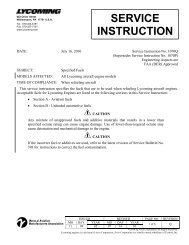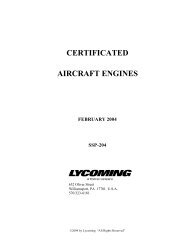You also want an ePaper? Increase the reach of your titles
YUMPU automatically turns print PDFs into web optimized ePapers that Google loves.
In addition, Grade 100LL has proved to be a satisfactory fuel for<br />
all <strong>Lycoming</strong> reciprocating aircraft engines. The higher octane<br />
level does not change engine operating temperatures, and engine<br />
deposits on the spark plugs and in the oil can be managed by using<br />
the techniques outlined in previous paragraphs.<br />
COMBUSTION DEPOSIT FOULING FUNDAMENTALS<br />
With the increase in recent years of the number of fuel injectors<br />
on our engines, there have been a number of complaints<br />
about a mysterious occasional engine “miss” in flight. We have<br />
been able to verify that the majority of these complaints on<br />
fuel-injected power plants are from contamination in the<br />
fuel — principally water. We have been telling operators for many<br />
years that fuel injectors and their systems are more vulnerable<br />
to contamination than are carburetors. Since water and other<br />
contaminants collect on the bottom of the airplane fuel tank, it<br />
also makes good sense not to make a practice of running a fuel<br />
tank dry.<br />
Careful draining of fuel sumps for water will help alleviate the<br />
“miss” problem. A sufficient amount of fuel must be drained<br />
to ensure getting the water. Experience indicates that draining<br />
should be accomplished before refueling, because fuel servicing<br />
mixes the water and fuel, and the water may not have settled<br />
to the bottom of the tank until the airplane is airborne. Learn<br />
to identify suspended water droplets in the fuel which causes<br />
the fuel to have a cloudy appearance; or the clear separation of<br />
water from the colored fuel after the water has settled to the<br />
bottom of the fuel tank.<br />
The <strong>Flyer</strong> articles reprinted here provide product<br />
information. Informed pilots and mechanics contribute<br />
to safe flying<br />
<strong>Lycoming</strong> does not permit the use of any fuel other than those<br />
specified in our latest edition of Service Instruction No. 1070.<br />
Although Supplemental Type Certificates (STC) now make the<br />
use of automotive fuel, which meets minimum specified standards,<br />
legal for use in some aircraft, reciprocating engine manufacturers<br />
and most major oil companies do not approve. While<br />
it is true that octane levels appear adequate, these organizations<br />
are of the opinion that the varying quality control standards<br />
applicable to automobile gasoline produce undue risk when it<br />
is used in aircraft. Several specific reasons are given for the<br />
non-approval of automobile fuel:<br />
1. Its use reduces safety. Although an operator may find that<br />
the engine runs well on a specific grade of auto fuel, there is no<br />
assurance that fuel from the same tank will be of the same quality<br />
when purchased the next time. Risk is increased.<br />
2. Its use can void warranty, or result in cancellation of the<br />
owner’s insurance.<br />
3. The storage characteristics of automotive fuel are less desirable<br />
in comparison with the good storage characteristics of aviation<br />
gasoline. After several months, stored automotive fuel may<br />
suffer loss of octane rating, and tends to deteriorate into hard<br />
starting, along with forming gum deposits that cause sticking<br />
exhaust and intake valves, and fuel metering problems, resulting<br />
in rough running engines. The turnover of automotive fuel is so<br />
fast that long-lasting storage characteristics are not required.<br />
4. The additives in automotive fuels are chemically different<br />
from those designed for aviation, and contain auxiliary scavengers<br />
which are very corrosive, and under continued use<br />
can lead to exhaust valve failures. They also cause rust and<br />
corrosion in the internal parts of the engine. The allowable<br />
additives for aviation gasoline are rigidly tested and controlled.<br />
There is no uniform control of additives in automotive gasoline.<br />
Many different additives are used, depending on the fuel manufacturer.<br />
For example, one fuel company adds a detergent to clean<br />
carburetors. This additive creates a significant increase in the<br />
affinity of the gasoline for water which can cause fuel filter icing<br />
problems in flight if outside temperatures are cold enough.<br />
5. Automotive fuels have higher vapor pressures than aviation<br />
fuel. This can lead to vapor lock during flight because the fuel<br />
companies advise that automotive fuels can have double the<br />
vapor lock pressures of aviation gasoline, depending on the seasons<br />
of the year and the location because of climatic conditions.<br />
In addition, automotive fuel also increases the possibility of<br />
vapor lock on the ground with a warm engine on a hot day.<br />
6. Although the fuel octane numbers shown on the pump of automotive<br />
and aircraft gasolines may be similar, the actual octane<br />
ratings are not comparable due to the different methods used to<br />
rate the two types of fuels. Furthermore, aviation gasolines have<br />
a lean and rich rating, i.e., 100/130, whereas motor gas is not<br />
tested for a rich rating.<br />
L y c o m i n g F l y e r







